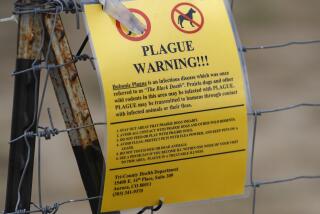Now more of a fluke than plague
- Share via
Each year in the western U.S., a handful of people come down with the plague, catching the ancient disease from animals (often rodents) that harbor the bacteria. A National Park Service employee recently died of the disease, and an Arizona woman became infected but survived.
Today, such cases get little press. But in ancient times, the plague evoked intense fear, panic and chaos -- for good reason. Throughout history, the disease has exacted a devastating toll on cities, countries and even entire continents.
In the 6th century, plague swept across Asia, Africa and Europe, hitting Constantinople -- then seat of the Roman Empire -- particularly hard. Over the course of the four-month epidemic in the city now known as Istanbul, 5,000 to 10,000 people a day died. When the city ran out of room for burials, the dead were piled on boats and sent out to sea. Even the emperor, Justinian, was infected. But although he recovered, his reign did not: The plague divided it neatly into a period of glory and a subsequent one of decline.
The most notorious plague epidemic struck Europe in the Middle Ages. Called the Black Death, the disease -- which caused painful, gruesome deaths and sometimes blackened the skin in the process -- threw the continent into turmoil. It killed one-third to half of the population, effecting lasting social and economic changes that, according to some historians, led the feudal system to crumble.
The plague resurfaced again in the ports of Hong Kong in the late 19th century, causing an epidemic that killed 100,000 but that seemed minor compared with the Black Death. In 1894, French scientist Alexandre Yersin identified a type of bacteria in the swollen lymph glands of plague-infected patients, and then isolated the same bacteria from infected mice. (The plague-causing bacteria, Yersinia pestis, is named for him.) Four years later, his compatriot Paul-Louis Simond showed that fleas spread the bacteria from sick rats to healthy rats -- and to people.
But news of plague’s relationship to fleas and rats didn’t spread as fast as the disease itself.
In 1900, plague reached the United States for the first time, surfacing in San Francisco’s Chinatown. As the disease spread, newspaper editorials called for Chinatown’s destruction. Health officials cordoned off the entire neighborhood, banned the city’s Asian population from traveling, and attempted to forcibly vaccinate Chinese San Franciscans -- actions that ultimately led to a class-action lawsuit settled in favor of the city’s Asian population.
The plague lingered in San Francisco until 1904, then disappeared for three years. But in 1907, the disease surfaced again. The 1906 earthquake had turned much of the city into a refugee camp, creating conditions that allowed the local rat population to explode.
Crowds of volunteers responded by spreading arsenic-tainted cheese on scraps of bread and placing the deadly bait around the city. Millions of rats died, and the epidemic subsided -- but not before plague took up permanent residence in the squirrels and mice in the hills to the east of the city. (Many rodents are unharmed by the bacteria; urban black rats, like humans, die of the infection.)
Plague returned to California one last time in 1924, this time causing an outbreak in Los Angeles. Health officials cordoned off Mexican immigrant neighborhoods, where the disease was thought to reside, killing cats, dogs and thousands of rats with poison, but also with guns and gas.
The California plagues killed relatively few: slightly more than 200 in San Francisco and 30 in Los Angeles. But like all epidemics of plague, they sparked social unrest and economic and political turmoil. Some U.S. states banned California visitors, produce and other goods. Central American countries refused to let California ships into harbors and accused the state of shipping plague-infested rats in their exports of vegetables.
That ability to cause panic has long made plague a weapon of war. In the medieval era, plague-ridden bodies were tossed over city walls by warring forces. During World War II, the Japanese dropped plague-infested fleas over China. The former Soviet Union stockpiled 20 tons of weapons-grade plague during the Cold War. The U.S. tried the same but couldn’t get the germs to stay virulent.
That’s why some scientists say that plague won’t ever make it as a weapon of mass destruction: It’s too unstable and not nearly infectious enough. In fact, just one form of plague is contagious. Fleas transmit bubonic plague from rodents to humans; when the infection reaches the lungs, it causes pneumonic plague, which then spreads from person to person. But since the advent of antibiotics -- and the disappearance of rats and fleas from most homes -- that rarely happens in the U.S.
Despite the country’s population of plague-carrying rodents and the handful of human cases that occur each year, plague hasn’t spread from person to person in the U.S. since the Los Angeles outbreak of 1924.
More to Read
Sign up for Essential California
The most important California stories and recommendations in your inbox every morning.
You may occasionally receive promotional content from the Los Angeles Times.










